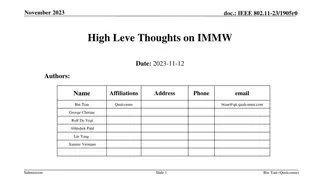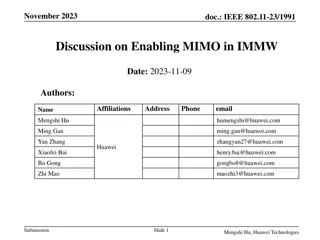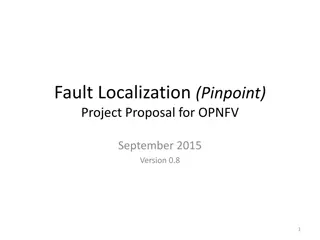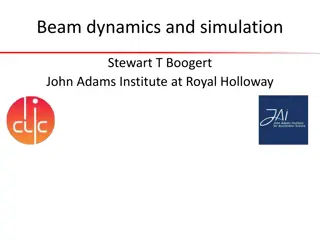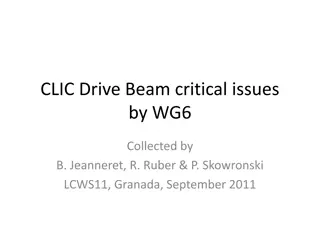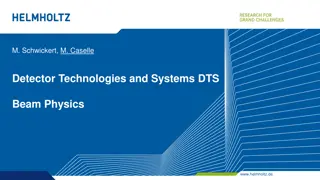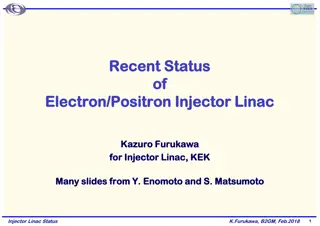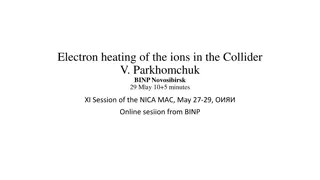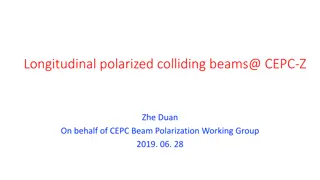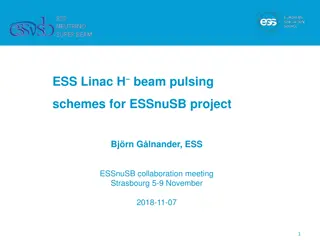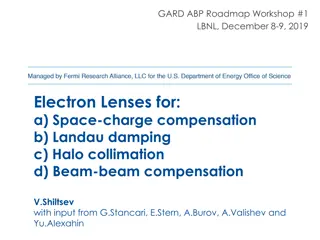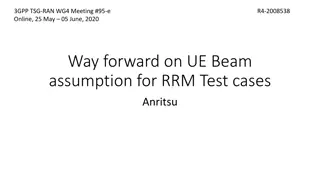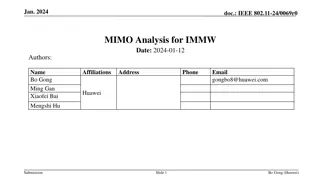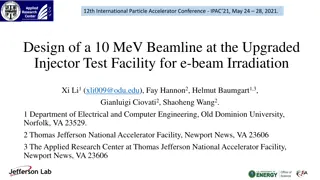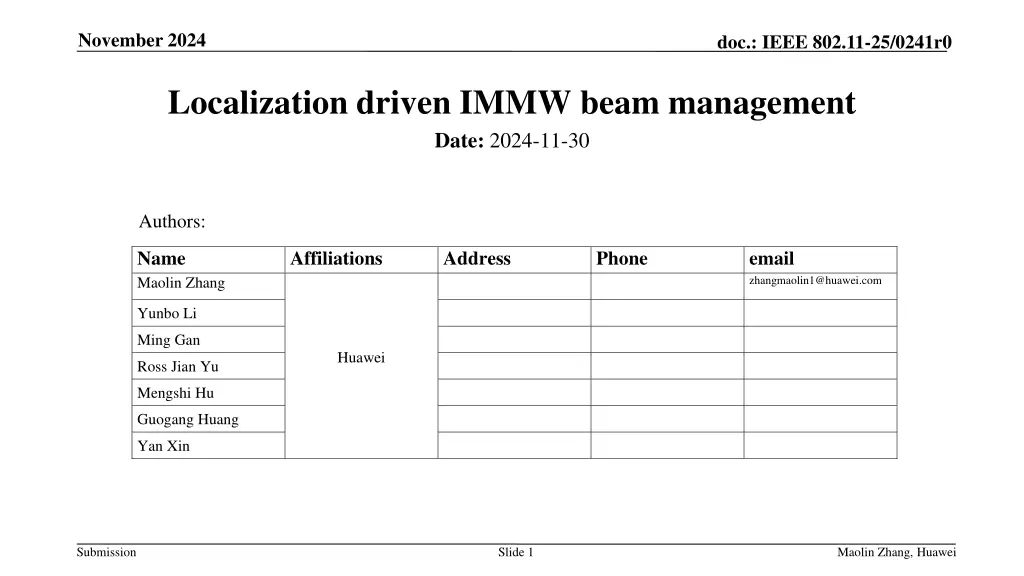
IMMW Beam Management for IEEE 802.11-25: November 2024 Update
Explore the latest advancements in Integrated mmWave (IMMW) technology for Wi-Fi networks with a focus on beam management. Discover the motivation behind utilizing millimeter wave frequencies, challenges with high attenuation, beamforming, and beam scanning, and strategies to overcome beam training overhead. Join Huawei experts as they delve into the future of IMMW beam management in AP and STA configurations.
Download Presentation

Please find below an Image/Link to download the presentation.
The content on the website is provided AS IS for your information and personal use only. It may not be sold, licensed, or shared on other websites without obtaining consent from the author. If you encounter any issues during the download, it is possible that the publisher has removed the file from their server.
You are allowed to download the files provided on this website for personal or commercial use, subject to the condition that they are used lawfully. All files are the property of their respective owners.
The content on the website is provided AS IS for your information and personal use only. It may not be sold, licensed, or shared on other websites without obtaining consent from the author.
E N D
Presentation Transcript
November 2024 doc.: IEEE 802.11-25/0241r0 Localization driven IMMW beam management Date: 2024-11-30 Authors: Name Maolin Zhang Affiliations Address Phone email zhangmaolin1@huawei.com Yunbo Li Ming Gan Huawei Ross Jian Yu Mengshi Hu Guogang Huang Yan Xin Submission Slide 1 Maolin Zhang, Huawei
November 2024 doc.: IEEE 802.11-25/0241r0 Introduction Integrated mmWave (IMMW) is promising for the whole Wi-Fi industry. In this contribution, we would like to consider beam management in IMMW. Submission Slide 2 Maolin Zhang, Huawei
November 2024 doc.: IEEE 802.11-25/0241r0 Motivation 2.4/5/6 GHz Wi-Fi : Omni directional transmission AP STA Submission Slide 3 Slide 3 Maolin Zhang, Huawei
November 2024 doc.: IEEE 802.11-25/0241r0 Motivation Millimeter wave: High attenuation AP STA Submission Slide 4 Slide 4 Maolin Zhang, Huawei
November 2024 doc.: IEEE 802.11-25/0241r0 Motivation Millimeter wave: High attenuation AP STA Submission Slide 5 Slide 5 Maolin Zhang, Huawei
November 2024 doc.: IEEE 802.11-25/0241r0 Motivation Millimeter wave: High attenuation Beamforming Beam scanning AP STA Submission Slide 6 Slide 6 Maolin Zhang, Huawei
November 2024 doc.: IEEE 802.11-25/0241r0 Motivation Millimeter wave: High attenuation Beamforming Beam scanning Beam alignment AP STA Submission Slide 7 Slide 7 Maolin Zhang, Huawei
November 2024 doc.: IEEE 802.11-25/0241r0 Motivation Millimeter wave: High attenuation Beamforming Beam scanning Beam alignment AP STA Submission Slide 8 Slide 8 Maolin Zhang, Huawei
November 2024 doc.: IEEE 802.11-25/0241r0 Motivation Millimeter wave: High attenuation Beamforming Beam scanning Beam alignment Millimeter wave has the key problem of high beam-training overhead, which limits its large-scale commercial use. Exhaustive scanning in a wide range of directions results in the high beam-training overhead or high latency. Make full use of IMMW characteristics to help IMMW beam management. AP STA Submission Slide 9 Slide 9 Maolin Zhang, Huawei
November 2024 doc.: IEEE 802.11-25/0241r0 Proposal 1: Determining whether there is LOS LOS (Line-of-Sight) NLOS (Non-line-of-Sight) Option1: Using Wi-Fi low-frequency to help determine whether there is LOS. For example, judging LOS or NLOS based on CSI (whether the signal component of the shortest path is the strongest). Option2: Aligning beams based on relative spatial position, sending millimeter wave signals to measure RSSI, and comparing the measured RSSI with the link budget results to see if the difference exceeds an threshold value, thereby determining whether it is LOS or NLOS. Submission Slide 10 Maolin Zhang, Huawei
November 2024 doc.: IEEE 802.11-25/0241r0 Proposal 2: Beam training with prior information Third beam group Second beam group First beam group Relative Direction TX can determine relative direction based on location information or localization results in LOS scenarios. TX scans the inner beam group first, then scans the outer beam group, and records some measurement results of each group. RX uses Wi-Fi low-frequency link to feedback measurement results during the scanning process. If the optimal beam quality in the current group is less than the optimal beam quality in the previous group, TX stops scanning and aligns the beam by the optimal beam from the previous group. Submission Slide 11 Maolin Zhang, Huawei
November 2024 doc.: IEEE 802.11-25/0241r0 Proposal 2: Beam training with prior information Third beam group Second beam group First beam group Intermediate results In NLOS/LOS scenarios, hierarchical beam scanning can be performed firstly. TX can determine the fine beam scanning range and relative direction (the central axis of the cone) based on the coarse beam scanning results. TX scans the inner beam group first, then scans the outer beam group, and records some measurement results of each group. RX uses Wi-Fi low-frequency link to feedback measurement results during the scanning process. If the optimal beam quality in the current group is less than the optimal beam quality in the previous group, TX stops scanning and aligns the beam by the optimal beam from the previous group. Submission Slide 12 Maolin Zhang, Huawei
November 2024 doc.: IEEE 802.11-25/0241r0 Summary In this contribution, we propose to make use of prior information to help IMMW beam management. We can utilize prior information from localization, sensing, intermediate results of hierarchical scanning, historical location etc. to narrow the beam scanning range and perform group scanning to improve beam alignment efficiency. Scanning the beam group with high probability first. During the beam scanning process, the low-frequency link is used to feedback measurement results so that the beam scanning can be terminated when the alignment conditions are met. Submission Slide 13 Maolin Zhang, Huawei
November 2024 doc.: IEEE 802.11-25/0241r0 References [1] 11-24-0116-07-immw-immw-draft-proposed-par [2] 11-23-1968-00-immw-discussion-on-general-direction-of-integrated-mmwave Submission Slide 14 Maolin Zhang, Huawei

